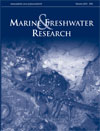Marine and Freshwater Research
Volume 63
Number 2 2012
Water quality observations in shallow, tidally-dominated, estuaries are variable in time and space. Seasonal, tidal and day-night variations in dissolved inorganic nutrients were examined, and tidal exchange was found to be a dominant control on nutrient concentrations. Accounting for these variations is critical to determining nutrient fluxes to the coast, and should be a fundamental constraint on sampling design.
Growth rates of juvenile southern rock lobster have not previously been quantified in the wild. We used a diver-based tag and recapture study to estimate growth of individuals between 40–80 mm carapace lengths and found that even at such early history stages, growth rates differentiated between sexes. The results contribute to the understanding of lobster population dynamics, especially in relation to fishery modelling.
Wind substantially influences the aquatic environment. We aimed to clarify that breezes on fine days with high air temperature increase sediment resuspension and phosphorus concentration in a shallow eutrophic lake. Since the breezes are induced by the elevation of air temperature, global change in temperature therefore likely affects the nutrient dynamics in shallow eutrophic lakes.
The relationship between fish morphology and dietary habits can provide key insights into the evolutionary diversification of fish groups. This study highlighted a significant relationship between the morphology and the trophic habits of northern Australia’s terapontid grunters. The parallels between the morphology of terapontids with ecologically similar fishes around the globe suggests similar evolutionary processes have shaped their morphology.
The corals of Heron Reef can be affected by variations in the underwater fields of ultraviolet and visible radiation. This study found significant spatial and temporal differences in the transmission of ultraviolet and visible radiation in the waters around this reef. The results will allow researchers to provide better estimates of the underwater light climate of corals at Heron Reef.
Failure to spawn in a significant proportion of adult fish may greatly decrease the reproductive output of a population and lead to overestimates of recruitment to the fish stock. Spawning failure is recorded to occur in a population of Chrysophrys auratus from the Kaipara Harbour, New Zealand. The harbour is the primary source for the C. auratus population along the west coast of the North Island of New Zealand, and thus, spawning failure in a localised population may increase the risk of broad-scale population depletion.
The presence of microcystin-producing cyanobacteria and of mucilaginous colonies is common in calcareous streams. To test the presence of microcystin in Rivularia colonies immunological techniques were used. Microcystins were present in trichome sheath and the colonial mucilage. It is suggested that microcystin are important for perduration of the colonies of such a slow growing organism
In New Zealand, the effects of paralytic shellfish poisoning (PSP) toxins on the physiology of bivalve molluscs are relatively unknown. We measured the short-term exposure of five species of bivalve to the toxic dinoflagellate Alexandrium tamarense, using clearance rate as an indication of their sensitivity to PSP toxins. We conclude that the species-specific rate of accumulation of PSP toxins in the tissues of the bivalve was influenced by their feeding behaviour and the different chemical processes that had taken place in their tissues.
Little is known about the temporal dynamics of biodiversity in relation to global change. We analysed changes in fish diversity over 10 years in south-western France. Although a decade of expanding urbanisation affected fish colonisation, agricultural lands experienced higher extinction rates. Extinction was greater among cold-tolerant exotics. Fish diversity is influenced by landscape alterations and by the thermal tolerance of species.
We tested the hypotheses that the diet of the Atlantoraja castelnaui changes with increasing body size, between seasons and regions and that prey size increased with predator’s size. A. castelnaui is a versatile, mainly piscivorous, consumer that shifts its diet with increasing body size and in response to seasonal and regional changes in prey abundance or distribution.




